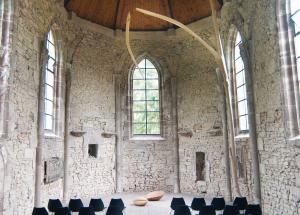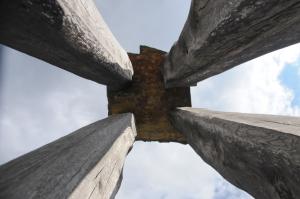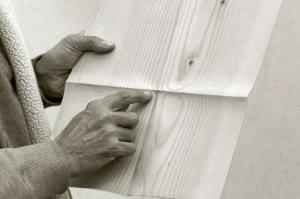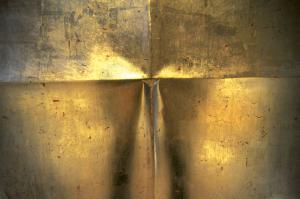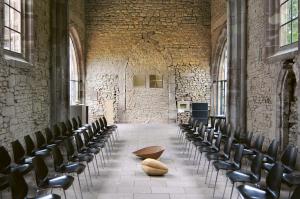THE CROSS IN THE VOID
Text | Photography: Peter Michael Lupp
Wooden panels: Hermann Bigelmayr
Place-related point of reference for the poetic thinking pictures
Cultural site Wintringer Chapel, Kleinblittersdorf. Former Premonstratensian priory of Wadgassen (first mentioned in the 14th century). Remains of the choir (15th century).
“The cross in the void” at the Wintringer Chapel Cultural site
Since 2011, Hermann Bigelmayr’s installation “The Limits to Growth” and the associated public discourse at the Wintringer Chapel Cultural site have been raising awareness of how the ecological limits of this planet are continually being exceeded. But where are the triggers for the fact that people are ultimately destroying the foundations of their existence through unreflective growth thinking? How can this perceived realization be translated into action? Are the driving forces and origins of the global growth dictate possibly hidden deep within humanity, where values are formed and shaped?
This incomplete mosaic of explanations provided the artist with points of reference to his previous works at the Wintringer Chapel Cultural site. A site-specific production of the two wall reliefs “The cross in the void”, as a means of interpretation for an adequate discussion, became the artistic strategy of choice.
Bigelmayr’s “Cross in the void” thus offers a pictorial counterpart to the symbolism of traditional religious world views, without forgetting to hold up a mirror to us.
The two square reliefs therefore deliberately hang like icons in front of the bricked-up portal, which does not seem to want to allow any breakthrough. Directly in front of it is a landscape dedicated to European coexistence in the Franco-German relationship as part of a Eurodistrict and, at the same time, a biosphere reserve promoting sustainable ways of life. But not much further from the gates of Europe, wars and crises are shaking entire state systems and world religions. In many cases, the actual arsonists cannot be identified, but the source of the fire is blazing and spreading. The view of the world structure is dominated by never-ending streams of displaced people.
The extent to which religious beliefs are partly responsible for this is a pressing and uncomfortable question in this country too, as they sometimes glorify violence. The symptoms of “pacification” are constantly growing louder, but why do established cultures and their religions lack the substance to reconcile the world?
Doesn’t the mission of the UNESCO biosphere reserves in particular make it an overriding duty to intensively promote regional research into the ethical foundations of sustainable and peaceful coexistence between people and in harmony with nature? Aren’t intercultural and interreligious concepts for reconciliatory ethics at the forefront of the European peace project?
These are the questions that “The Cross in the Nothingness” at the Wintringer Chapel Cultural site brings into focus. May the sighting trigger creative impulses in the viewers - towards independent reflection on what personal ingredients can be added to a reconciliatory ethic. Some, however, would certainly prefer to kneel down in order to fade out.

